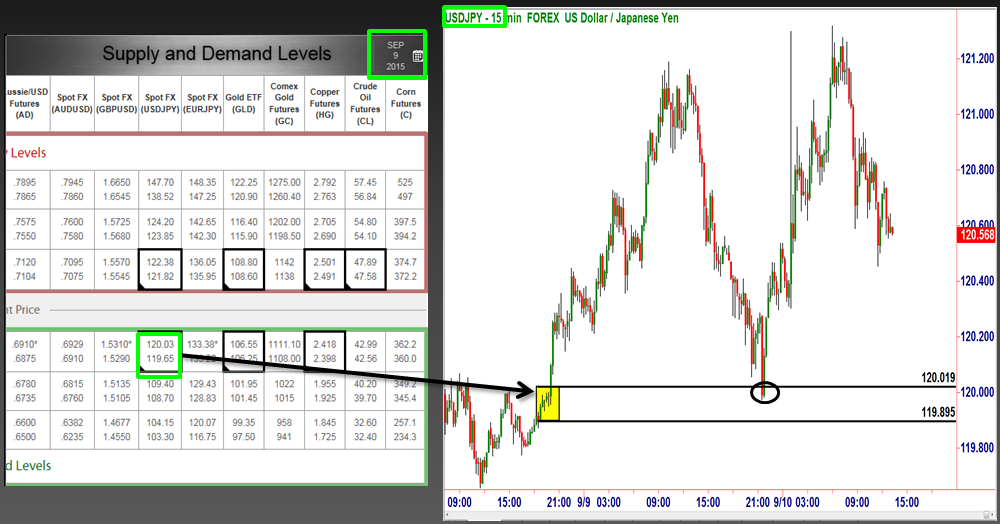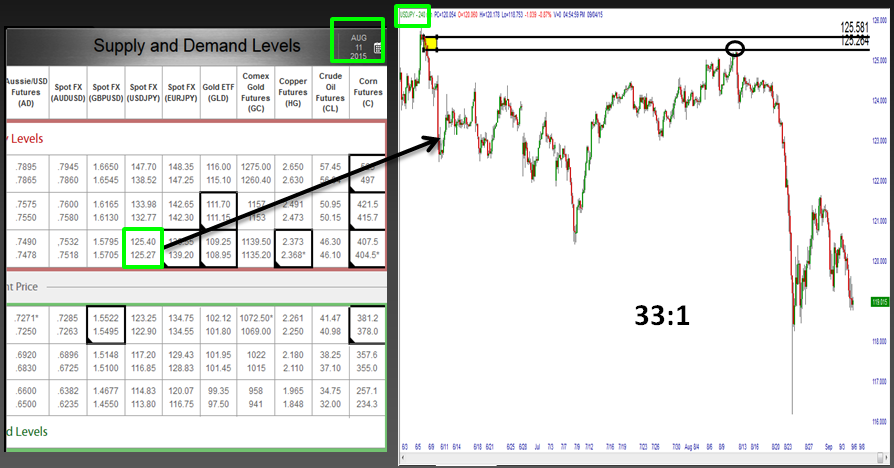![]()
When using supply and demand to identify turning points in a market, a question that comes up often is, “How far back should I look for a supply and demand level?” The proper answer is this: Look back as far as you need to in order to find “fresh” demand and supply. The key word is fresh as those represent the highest probability turning points. At those points, you have the highest amount of unfilled buy and sell orders. The definition of fresh is beyond the scope of this piece but that’s ok.
Since the OTA Supply/Demand Grid began March 1, 2012, our Supply and Demand service has identified the turning points in some of the major markets much of the time. We produce these levels and release them each weekday very early in the morning. The reason for the consistency is that we are focused only on bank and financial institution demand and supply, nothing else. In other words, the levels that you see on the grid below are “fresh” demand and supply. Having this information as an income trader or longer term investor is key.
Supply Demand Grid 9/10/15 – USDJPY
Notice the demand level above. To the left of it, price struggled moving higher and declined from that area a couple times. Then, price finally moved past that level leaving a fresh demand zone (yellow shaded area). In other words, the supply demand equation at that level flipped. The very next day, price declined back to that level (circled area) and rallied, offering OTA grid members a low risk, high reward and high probability buying opportunity. The question many students had was: “How was that level found given that the last time price had been there was over a day ago?” While I don’t have room to explain it in full here, we can explore some points of interest in hopes that the information will help take your trading to the next level.
Sometimes, when price is far out on the curve, we look back months and years to find fresh levels. When we looked back, we looked for the picture on the chart that represented fresh demand, and there it was. It also had all our “Odds Enhancers” associated with it which made it a key level. I am not suggesting that all the same buyers who bought at that level 2 days earlier are still sitting there with buy orders, though some likely are, that’s not the case. What the chart does however is show us the aggregate supply and demand equation at each price point in a market.
Supply Demand Grid 8/11/15 – USDJPY
In this next example we had to look back almost 2 months to identify the fresh supply level that met our Odd Enhancer criteria. As you can see on the chart, price rallied up to that level (circled area) and collapsed as it should. This offered our students/traders a low risk, very high reward and extremely high probability shorting opportunity. This one created a few more email questions from students asking: “Are supply and demand levels from a long time ago any good?” The answer is yes, yes, yes… In fact, these are some of my favorites. The reason is this… Think about it, the fact that price is revisiting a supply or demand level from so long ago means by definition, “price” is way out on the supply and demand curve, extremely high or low. This means levels in these areas are going to carry strong odds of working and have huge profit zones. I find it so interesting that most people are not comfortable entering positions in markets at extremes and instead want to trade in the middle. All the best odds and biggest profit zones are out at the extremes.
The point of this piece is not to impress you, but more importantly to impress upon you two very important things:
1) The key to knowing where market prices are going to turn in advance and also where prices are going to go with a very high degree of accuracy means knowing exactly what institution/bank demand and supply looks like on a price chart in any market and any time frame. This is our focus in the XLT and Mastermind Community where the Supply/Demand grid is found.
2) Understand that supply and demand levels created long ago can serve to be very strong levels. The fact that they were created long ago is not a bad thing, it’s actually a positive for those reasons.
Hope this was helpful, have a great day.
Note: All information on this page is subject to change. The use of this website constitutes acceptance of our user agreement. Please read our privacy policy and legal disclaimer. Opinions expressed at FXstreet.com are those of the individual authors and do not necessarily represent the opinion of FXstreet.com or its management. Risk Disclosure: Trading foreign exchange on margin carries a high level of risk, and may not be suitable for all investors. The high degree of leverage can work against you as well as for you. Before deciding to invest in foreign exchange you should carefully consider your investment objectives, level of experience, and risk appetite. The possibility exists that you could sustain a loss of some or all of your initial investment and therefore you should not invest money that you cannot afford to lose. You should be aware of all the risks associated with foreign exchange trading, and seek advice from an independent financial advisor if you have any doubts.
Editors’ Picks
EUR/USD retreats below 1.0700 after US GDP data

EUR/USD came under modest bearish pressure and retreated below 1.0700. Although the US data showed that the economy grew at a softer pace than expected in Q1, strong inflation-related details provided a boost to the USD.
GBP/USD declines below 1.2500 as USD rebounds

GBP/USD declined below 1.2500 and erased the majority of its daily gains with the immediate reaction to the US GDP report. The US economy expanded at a softer pace than expected in Q1 but the price deflator jumped to 3.4% from 1.8%.
Gold holds near $2,330 despite rising US yields

Gold stays in positive territory near $2,330 in the second half of the day on Thursday. The benchmark 10-year US Treasury bond yield is up more than 1% on the day above 4.7% after US GDP report, making it difficult for XAU/USD to extend its daily rally.
XRP extends its decline, crypto experts comment on Ripple stablecoin and benefits for XRP Ledger

Ripple extends decline to $0.52 on Thursday, wipes out weekly gains. Crypto expert asks Ripple CTO how the stablecoin will benefit the XRP Ledger and native token XRP.
After the US close, it’s the Tokyo CPI

After the US close, it’s the Tokyo CPI, a reliable indicator of the national number and then the BoJ policy announcement. Tokyo CPI ex food and energy in Japan was a rise to 2.90% in March from 2.50%.
RECOMMENDED LESSONS
Making money in forex is easy if you know how the bankers trade!
Discover how to make money in forex is easy if you know how the bankers trade!
5 Forex News Events You Need To Know
In the fast moving world of currency markets, it is extremely important for new traders to know the list of important forex news...
Top 10 Chart Patterns Every Trader Should Know
Chart patterns are one of the most effective trading tools for a trader. They are pure price-action, and form on the basis of underlying buying and...
7 Ways to Avoid Forex Scams
The forex industry is recently seeing more and more scams. Here are 7 ways to avoid losing your money in such scams: Forex scams are becoming frequent. Michael Greenberg reports on luxurious expenses, including a submarine bought from the money taken from forex traders. Here’s another report of a forex fraud. So, how can we avoid falling in such forex scams?
What Are the 10 Fatal Mistakes Traders Make
Trading is exciting. Trading is hard. Trading is extremely hard. Some say that it takes more than 10,000 hours to master. Others believe that trading is the way to quick riches. They might be both wrong. What is important to know that no matter how experienced you are, mistakes will be part of the trading process.


